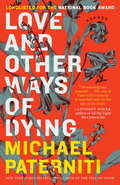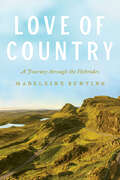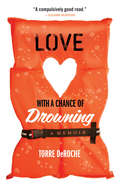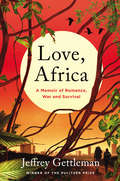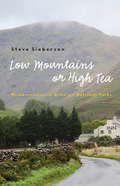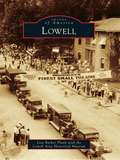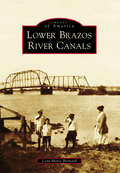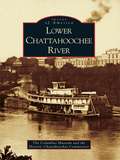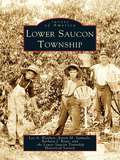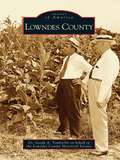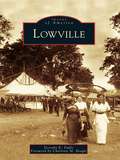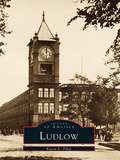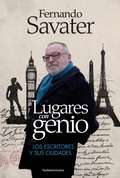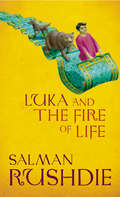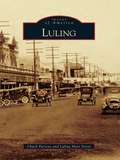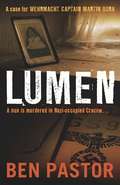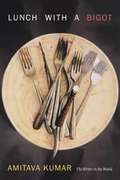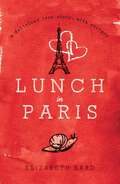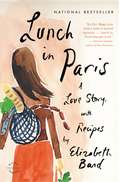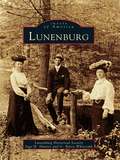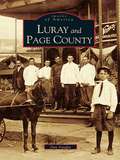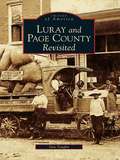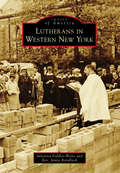- Table View
- List View
Love and Other Ways of Dying
by Michael PaternitiIn this moving, lyrical, and ultimately uplifting collection of essays, Michael Paterniti turns a keen eye on the full range of human experience, introducing us to an unforgettable cast of everyday people. Michael Paterniti is one of the most original and empathic storytellers working today. His writing has been described as "humane, devastating, and beautiful" by Elizabeth Gilbert, "spellbinding" by Anthony Doerr, and "expansive and joyful" by George Saunders. In the seventeen wide-ranging essays collected for the first time in Love and Other Ways of Dying, he brings his full literary powers to bear, pondering happiness and grief, memory and the redemptive power of human connection. In the remote Ukranian countryside, Paterniti picks apples (and faces mortality) with a real-life giant; in Nanjing, China, he confronts a distraught jumper on a suicide bridge; in Dodge City, Kansas, he takes up residence at a roadside hotel and sees, firsthand, the ways in which the racial divide turns neighbor against neighbor. In each instance, Paterniti illuminates the full spectrum of human experience, introducing us to unforgettable everyday people and bygone legends, exploring the big ideas and emotions that move us. Paterniti reenacts François Mitterrand's last meal in a rustic dining room in France and drives across America with Albert Einstein's brain in the trunk of his rental car, floating in a Tupperware container. He delves with heartbreaking detail into the aftermath of a plane crash off the coast of Nova Scotia, an earthquake in Haiti, and a tsunami in Japan--and, in searing swirls of language, unearths the complicated, hidden truths these moments of extremity teach us about our ability to endure, and to love. Michael Paterniti has spent the past two decades grappling with some of our most powerful subjects and incomprehensible events, taking an unflinching point of view that seeks to edify as it resists easy answers. At every turn, his work attempts to make sense of both love and loss, and leaves us with a profound sense of what it means to be human. As he writes in the Introduction to this book, "The more we examine the grooves and scars of this life, the more free and complete we become." Praise for Michael Paterniti "A fearless, spellbinding collection of inquiries by a brilliant, globally minded essayist whose writing is magic and whose worldview brims with compassion . . . Genius chefs, an eight-and-a-half-foot-tall giant, an earthquake, a jet crash, and a president who eats songbirds--the size of Michael Paterniti's curiosity is matched only by the size of his heart."--Anthony Doerr, author of All the Light We Cannot See "Michael Paterniti is a genius."--Elizabeth Gilbert, author of The Signature of All Things "Michael Paterniti is one of the best living practitioners of the art of literary journalism, able to fully elucidate and humanize the everyday and the epic. In his hands, every subject, every moment of personal or global upheaval, is treated with the same curiosity, respect, empathy, and clear-eyed wisdom."--Dave Eggers, author of The Circle "I have been waiting years for this collection. In each of these essays, Michael Paterniti unveils life for us, the beauty and heartbreak of it, as we would never see it ourselves but now can never forget it. Paterniti is brilliant--a rare master--and one of my favorite authors on earth."--Lily King, author of EuphoriaFrom the Hardcover edition.
Love in Five Acts
by Daniela Krien"Highly recommended" Sunday Times"Utterly captivating" Woman and Home"Sympathetic and clear-eyed" Financial Times Summer Reads of 2021"Unfailingly impressive" Irish Times"Sparse and precise" Telegraph"Beautifully direct and lucid prose . . . fierce intelligence" Melbourne Age & Sydney Morning Herald"A beautiful novel of what it is to be a women in modern Europe" New European"An intelligent study of female desire, ambition and frailty" ObserverBookseller Paula has lost a child, and a husband. Where will she find her happiness? Fiercely independent Judith thinks more of horses than men, but that doesn't stop her looking for love online. Brida is a writer with no time to write, until she faces a choice between her work and her family. Abandoned by the "perfect" man, Malika struggles for recognition from her parents. Her sister Jorinde, an actor, is pregnant for a third time, but how can she provide for her family alone? Love in Five Acts explores what is left to five women when they have fulfilled their roles as wives, mothers, friends, lovers, sisters and daughters. As teenagers they experienced the fall of the Berlin Wall, but freedom brings with it another form of pressure: the pressure of choice. Punchy and entirely of the moment, Love in Five Acts engages head-on with what it is to be a woman in the twenty-first century.Translated from the German by Jamie Bulloch
Love in Five Acts
by Daniela Krien"Highly recommended" Sunday Times"Utterly captivating" Woman and Home"Sympathetic and clear-eyed" Financial Times Summer Reads of 2021"Unfailingly impressive" Irish Times"Sparse and precise" Telegraph"A beautiful novel of what it is to be a women in modern Europe" New European"An intelligent study of female desire, ambition and frailty" ObserverrFive women attempt the impossible - to love, to be strong, and to stay true to themselves.Bookseller Paula has lost a child, and a husband. Where will she find her happiness? Fiercely independent Judith thinks more of horses than men, but that doesn't stop her looking for love online. Brida is a writer with no time to write, until she faces a choice between her work and her family. Abandoned by the "perfect" man, Malika struggles for recognition from her parents. Her sister Jorinde, an actor, is pregnant for a third time, but how can she provide for her family alone? Love in Five Acts explores what is left to five women when they have fulfilled their roles as wives, mothers, friends, lovers, sisters and daughters. As teenagers they experienced the fall of the Berlin Wall, but freedom brings with it another form of pressure: the pressure of choice. Punchy and entirely of the moment, Love in Five Acts engages head-on with what it is to be a woman in the twenty-first century.Spiegel #1 bestseller - More than 150,000 copies sold in GermanyTranslated from the German by Jamie Bulloch(P)2021 Quercus Editions Limited
Love of Country: A Journey through the Hebrides
by Madeleine Bunting&“Excellent . . . Almost the perfect marriage of travelogue to the inner landscape of political ideas and cultural reflections . . . a super read.&” —New Statesman Few landscapes are as striking as that of the Hebrides, the hundreds of small islands that speckle the waters off Scotland&’s northwest coast. The jagged, rocky cliffs and roiling waves serve as a reminder of the islands&’ dramatic geological history. Facing the Atlantic, the Hebrides were at the center of ancient shipping routes and have a remarkable cultural history. After years of hearing about Scotland as a place interwoven with the story of her family, Madeleine Bunting went to see for herself this place so full of history. Over six years, Bunting returned again and again to the Hebrides, fascinated by the question of what it means to belong there. With great sensitivity, she takes readers through the Hebrides&’ history of dispossession and displacement, a history that can be understand only in the context of Britain&’s imperial past, and she shows how the Hebrides have been repeatedly used to define and imagine Britain.Love of Country is a revelatory journey through one of the world&’s most remote, beautiful landscapes that encourages us to think of the many identities we wear as we walk our paths. &“A remarkably thorough digest of the many histories of the Hebrides.&” —Wall Street Journal &“Moving and wonderful. . . . Both the author and reader of this book end up losing themselves not just in politics and history and the details of nature, but a sense of wonder&” —The Guardian &“Makes you feel you are there even if you have just left.&” —Observer, Best Books of the Year
Love with a Chance of Drowning
by Torre DeRocheNew love. Exotic destinations.A once-in-a-lifetime adventure.What could go wrong? City girl Torre DeRoche isn't looking for love, but a chance encounter in a San Francisco bar sparks an instant connection with a soulful Argentinean man who unexpectedly sweeps her off her feet. The problem? He's just about to cast the dock lines and voyage around the world on his small sailboat, and Torre is terrified of deep water. However, lovesick Torre determines that to keep the man of her dreams, she must embark on the voyage of her nightmares, so she waves good-bye to dry land and braces for a life-changing journey that's as exhilarating as it is terrifying. Somewhere mid-Pacific, she finds herself battling to keep the old boat, the new relationship, and her floundering sanity afloat. . . . This sometimes hilarious, often harrowing, and always poignant memoir is set against a backdrop of the world's most beautiful and remote destinations. Equal parts love story and travel memoir, Love with a Chance of Drowning is witty, charming, and proof positive that there are some risks worth taking.
Love, Africa: A Memoir of Romance, War, and Survival
by Jeffrey Gettleman“A page-turner. The portrait of Africa that emerges is disturbing, tender, and harsh. . . . A tremendous read. I couldn’t put it down.” —Abraham Verghese, New York Times–bestselling author of The Covenant of WaterA seasoned war correspondent, Jeffrey Gettleman has covered every major conflict over the past twenty years, from Afghanistan to Iraq to the Congo. For the past decade, he has served as the East Africa bureau chief for the New York Times, fulfilling a teenage dream.At nineteen, Gettleman fell in love, twice. On a do-it-yourself community service trip in college, he went to East Africa—a terrifying, exciting, dreamlike part of the world in the throes of change that imprinted itself on his imagination and on his heart.But around that same time he also fell in love with a fellow Cornell student—the brightest, classiest, most principled woman he’d ever met. To say they were opposites was an understatement. She became a criminal lawyer in America; he hungered to return to Africa. For the next decade he would be torn between these two abiding passions.A sensually rendered coming-of-age story, Love, Africa is a tale of passion, violence, far-flung adventure, tortuous long-distance relationships, screwing up, forgiveness, parenthood, and happiness that explores the power of finding yourself in the most unexpected of places. “Aptly displays why [Gettleman's] a Pulitzer Prize winner and a New York Times bureau chief . . . there's a thrilling immediacy and attention to detail in Gettleman's writing that puts the reader right beside him. . . . An absolute must-read.” —Booklist, starred review“Love, Africa offers a key to understanding humankind’s past and future and a key to understanding our hearts.” —Sheryl Sandberg
Low Mountains or High Tea: Misadventures in Britain's National Parks
by Steve SiebersonWhen Steve Sieberson and his wife unexpectedly found themselves in Britain with an entire summer on their hands, they readily agreed to avoid the usual tourist attractions, opting instead for a road trip to the UK’s far-flung national parks. As they set out, however, he envisioned bracing days of energetic hillwalking, while she assumed they would relax in tearooms and cozy pubs. Seldom planning more than a few days in advance, the two traversed the country in a rented Vauxhall, subjecting themselves to single-track lanes, diabolical signage, and whimsical advice from locals. They discovered a town called Mirthless, a place where cats’ eyes are removed, and a vibrating cottage, while at mealtimes they dove fearlessly into black pudding, Eton mess, and barely recognizable enchiladas. Meanwhile, after their initial attempts at hiking together nearly ended in disaster, Sieberson received dispensation to scramble alone to the highest point in each national park—as long as he was quick about it and left plenty of time for more sedentary pursuits. Low Mountains or High Tea dishes up the charms and eccentricities of rural Great Britain as seen through the eyes of two Americans who never really knew what was coming next.
Lowell
by Lisa Barker Plank Lowell Area Historical MuseumSettlement of the Lowell area centered on the confluence of the Grand and Flat Rivers. Joseph and Magdaleine LaFramboise first established a fur trading post near the Ottawa village, Segwun, where the rivers meet. The community grew as settlers poured into the area attracted by the growing lumber industry and rich farmland. Diverse businesses emerged including a cutter factory, a vibrant clamming industry, and the state's oldest family-run flour mill. A unique feature of the area is Fallasburg Historic Village. Once an active mill town on the Flat River, Fallasburg slid into obscurity when the railroad passed it by. At the height of the Great Depression, businessmen of Lowell joined together to build a showboat to draw visitors to town. The Lowell Showboat is now one of the most recognizable attractions in Lowell. This book explores both well known and more obscure aspects of Lowell's history through a wealth of images, many never published before.
Lower Brazos River Canals
by Lora-Marie BernardCommunities have spent more than 100 years mastering the mighty Brazos River and its waterways. In the 1800s, Stephen F. Austin chose the Brazos River as the site for the first Texas colony because of its vast water and fertile soil. Within 75 years, a pumping station would herald the way for crop management. A sugar mill that was eventually known as Imperial Sugar spurred community development. In 1903, John Miles Frost Jr. tapped the Brazos to expand the Cane and Rice Belt Irrigation System while Houston newspapers predicted the infrastructure marvel would change the region's future--and it did. Within a few decades, the Texas agricultural empire caused Louisiana to dub Texas farmers "the sugar and rice aristocracy." As the dawn of the industrial age began, the Brazos River and its waterways began supplying the Texas Gulf Coast industry.
Lower Chattahoochee River
by The Columbus Museum Historic Chattahoochee CommissionThe Chattahoochee River has dramatically shaped the heritage of the lower Chattahoochee Valley of east and southeast Alabama and west and southwest Georgia. As the region's dominant geographic feature, the Chattahoochee has served residents of the area as an engine for commerce and as an important transportation route for centuries. It has also been a natural and recreational resource, as well as an inspiration for creativity. From the stream's role as one of the South's busiest trade routes to the dynamic array of water-powered industry it made possible, the river has been at the very center of the forces that have shaped the unique character of the area. A vital part of the community's past, present, and future, it binds the Chattahoochee Valley together as a distinctive region. Through a variety of images, including historic photographs, postcards, and artwork, this book illustrates the importance of the Chattahoochee River to the region it has helped sustain.
Lower Saucon Township (Images of America)
by Karen M. Samuels Lee A. Weidner Barbara J. Ryan Lower Saucon Township Historical SocietyLower Saucon Township provides a unique glimpse of the region's many diverse villages and the German immigrant population. Towns including Wassergass, Shimersville, Polk Valley, Redington, and Bingen were settled largely because of the area's fertile soil, abundant water, and many iron and limestone deposits, which contributed to surrounding communities such as Bethlehem and Hellertown both socially and economically. These rare family photographs depict a blend of lives that influenced the area before and after the industrial revolution.
Lowndes County (Images of America)
by Lowndes County Historical Society Dr Joseph TomberlinLowndes County, located deep in the wiregrass region of southern Georgia, has been continuously occupied since ancient times. Through the centuries, various Native American tribes inhabited the region, but they lingered relatively briefly and left few tangible traces. The area's written history began with the establishment around 1623 of the Spanish mission of Santa Cruz de Cachipile in southern Lowndes. Georgia's general assembly created Lowndes County from the southern half of Irwin County in 1825 and named it for William Jones Lowndes of South Carolina. The present county seat, Valdosta, dates from the construction of the Atlantic and Gulf Railroad across Lowndes from 1859 to 1860. Ultimately the county was to have five railroads, which, combined with U.S. Highways 41 and 84 and Interstate 75, were to be major factors in dramatic local growth."
Lowville
by Charlotte M. Beagle Dorothy K. DufloLowville, first settled in 1796, is part of the Black River valley, an area laden with fertile land and rich forests. The town continued to develop through the years, supporting hotels, flour mills and gristmills, furniture manufacturers, cheese plants, tanneries, and even a brewery. Lowville's place in history was sealed when, by 1878, it was producing eight million pounds of cheese annually with a value at that time of $1 million. The earlier manufacturing businesses gradually faded, and Lowville ushered in the 20th century as an important dairy center, a tradition that continues to this day.
Ludlow (Images of America)
by Karen E. PilonIncorporated on February 28, 1774, Ludlow, Massachusetts, was originally a part of Springfield. The origin of the name remains a mystery, though the most probable explanation is that it was named afterRoger Ludlow, an early prominent New England citizen who played a great part in building up the town and taking care of its citizens. The Ludlow Manufacturing Company, formed around 1900 by Charles T. Hubbard, helped shape the town by providing housing, a library, schools, playgrounds, and even a clubhouse for the diverse community. Ludlow was home to many sawmills and gristmills, utilizing the power from the several sources of water nearby, including the Chicopee River, Broad Brook, Higher Brook, and Stony Brook. The town is most noted, however, for its factory mills and production of jute yarns, twine, and webbing. Less well known was the glass-making business that was prevalent in the early 1800s. John Sikes manufactured glass bottles andother glassware and the Ludlow Manufacturing Company glass works operated for only a short time before closing in the depression years following the War of 1812. Today, Ludlow remains a culturally diversecommunity made up of Portuguese, Polish, French, and Irish residents, just to name a few.
Lugares con genio: Los escritores y sus ciudades
by Fernando SavaterDos placeres: literatura y viajes. Cómo las ciudades influenciaron lavida y la obra de autores como Virginia Woolf, Octavio Paz, Jorge LuisBorges, Franz Kafka, entre otros. Este maravilloso libro conjuga las dos grandes pasiones de FernandoSavater: la literatura y los viajes. Recorriendo las principalesciudades del mundo, Savater nos lleva de la mano por los lugares quefrecuentaron los grandes escritores. Mezcla de diario de viaje ybiografía, en este libro nos encontramos con el profundo lazo queune a un autor con su ciudad de origen: Londres y Virginia Woolf, Méxicoy Octavio Paz, Santiago de Chile y Pablo Neruda, Buenos Aires y JorgeLuis Borges, Praga y Franz Kafka, Lisboa y Fernando Pessoa, Florencia yDante Alighieri, Edimburgo y Stevenson, Gran Bretaña y Chateaubriand,entre otros.Con su sello personal -siempre recreativo y ameno, lejos de lasolemnidad del homenaje-, conocemos los sitios emblemáticos de cadaautor, rastreamos los vestigios de su paso y el ímpetu de la ciudadsobre su obra.Savater se sumerge en la idiosincrasia de cada ciudad; explora su vidacotidiana, su gastronomía y sus hitos, buscando la influencia queejerció cada lugar en la vida de los autores.«Lugares con genio» descubre esos rincones célebres y secretos, quesirvieron de escenario o inspiración para la gran literatura mundial.
Luka and the Fire of Life
by Salman RushdieOn a beautiful starry night in the city of Kahani in the land of Alifbay a terrible thing happened: twelve-year-old Luka's storyteller father, Rashid, fell suddenly and inexplicably into a sleep so deep that nothing and no one could rouse him. To save him from slipping away entirely, Luka must embark on a journey through the Magic World, encountering a slew of phantasmagorical obstacles along the way, to steal the Fire of Life, a seemingly impossible and exceedingly dangerous task. With Haroun and the Sea of Stories Salman Rushdie proved that he is one of the best contemporary writers of fables, and it proved to be one of his most popular books with readers of all ages. While Haroun was written as a gift for his first son, Luka and the Fire of Life, the story of Haroun's younger brother, is a gift for his second son on his twelfth birthday. Lyrical, rich with word-play, and with the narrative tension of the classic quest stories, this is Salman Rushdie at his very best.
Luling (Images of America)
by Luling Main StreetOne historian described Luling in the 1870s as "the toughest town in Texas." Along with the railroad came notorious gamblers who were ready to take a man's hard-earned money any way they could. But when settlers enforced what laws there were and established permanent homes, churches, and a school, the rougher crowd sought greener pastures. In the southern corner of Caldwell County, Luling had at first an agrarian-based economy, but that changed with the discovery of oil, which boosted the population from a few hundred residents to several thousand. The oil industry and related businesses kept the population steady. Luling soil also proved beneficial to crops such as cotton, but the area's prize crop became watermelons. Today oil and watermelons keep Luling on the map, and the annual Watermelon Thump attracts thousands. At the crossroads of three important highways, businesses flourish, especially barbecue, which is considered by some to be the best in the state.
Lumen
by Ben PastorEqual parts wartime political intrigue, detective story, psychological thriller and religious mystery, Pastor's debut follows a German army captain and a Chicago priest as they investigate the death of a nun in Nazi-occupied Poland. Stunned by the violence of the occupation and by the ideology of his colleagues, Bora's sense of Prussian duty is tested to the breaking point.
Lunch With a Bigot: The Writer in the World
by Amitava KumarTo be a writer, Amitava Kumar says, is to be an observer. The twenty-six essays in Lunch with a Bigot are Kumar's observations of the world put into words. A mix of memoir, reportage, and criticism, the essays include encounters with writers Salman Rushdie and Arundhati Roy, discussions on the craft of writing, and a portrait of the struggles of a Bollywood actor. The title essay is Kumar's account of his visit to a member of an ultra-right Hindu organization who put him on a hit-list. In these and other essays, Kumar tells a broader story of immigration, change, and a shift to a more globalized existence, all the while demonstrating how he practices being a writer in the world.
Lunch in Paris: A Delicious Love Story, with Recipes
by Elizabeth BardPart love story, part cookbook, Lunch in Paris is a forthright and funny story of falling in love with a Frenchman and moving to the world’s most romantic city. From gutting her first fish to discovering the French version of Death by Chocolate, Elizabeth finds that learning to cook and building a new life have a lot in common.
Lunch in Paris: A Love Story, with Recipes
by Elizabeth BardIn Paris for a weekend visit, Elizabeth Bard sat down to lunch with a handsome Frenchman--and never went home again. Was it love at first sight? Or was it the way her knife slid effortlessly through her pavé au poivre, the steak's pink juices puddling into the buttery pepper sauce? LUNCH IN PARIS is a memoir about a young American woman caught up in two passionate love affairs--one with her new beau, Gwendal, the other with French cuisine. Packing her bags for a new life in the world's most romantic city, Elizabeth is plunged into a world of bustling open-air markets, hipster bistros, and size 2 femmes fatales. She learns to gut her first fish (with a little help from Jane Austen), soothe pangs of homesickness (with the rise of a chocolate soufflé) and develops a crush on her local butcher (who bears a striking resemblance to Matt Dillon). Elizabeth finds that the deeper she immerses herself in the world of French cuisine, the more Paris itself begins to translate. French culture, she discovers, is not unlike a well-ripened cheese-there may be a crusty exterior, until you cut through to the melting, piquant heart. Peppered with mouth-watering recipes for summer ratatouille, swordfish tartare and molten chocolate cakes, Lunch in Paris is a story of falling in love, redefining success and discovering what it truly means to be at home. In the delicious tradition of memoirs like A Year in Provence and Under the Tuscan Sun, this book is the perfect treat for anyone who has dreamed that lunch in Paris could change their life.
Lunenburg
by Inge H. Hunter Lunenburg Historical Society G. Barry WhitcombThe name "Luneburg" was coined for King George II of England, who was also the duke of Luneburg, Germany, in 1727. The final name, Lunenburg, was probably a result of misspelling in the early records of the town. On August 1, 1728, Lunenburg was officially granted township but, as early as 1726, a variety of industries had been started and twenty-six houses had been built. In the late nineteenth century, the town returned to predominately agriculture and, today, is a rural residential community for industries in neighboring cities. Through a diverse collection of vintage images, Lunenburg will take you on a historical journey through the town's engaging past. Within these pages, you will see photographs of the early businesses that were established, such as bookbinders, blacksmiths, furniture makers, and shoe manufacturers; you will visit many homes, churches, schools and government buildings; and you will experience the daily lives of residents during this exciting time in history.
Luray and Page County (Images of America)
by Dan VaughnFormed out of necessity in 1831, Page County had a great need to operate within its own boundaries of the Massanutten and Blue Ridge Mountains. A very unique situation arose when this rural area was coupled with the discovery in 1878 of something as spectacular as the Luray Caverns. Along with this new fame followed a large influx of tourists, industry, and varied commerce into the entire county from the lifeline created by the formation of the Shenandoah Valley Railroad in 1881. During the reconstruction years after the Civil War, and with the formation of "land and improvement" companies throughout the United States, Page County, along with the rest of the country, was booming. In fact, this unbridled growth was happening much too fast for this newly reformed country. This in turn brought about a severe recession in the 1890s that affected everyone, including the people of Page, no matter how secure they may have seemed with their new attraction. The culmination of these events initiated a quaint photographic history that is contained within the pages of Images of America: Luray and Page County.
Luray and Page County Revisited
by Dan VaughnLuray Caverns, discovered in the quiet valley community of Luray in 1878, became the main attraction in Page County. In hopes of capitalizing on this new found "Wonder of the World," executives of the Shenandoah Valley Railroad completed the rail from Hagerstown and Basic City to Luray by 1881. Mann Almond drove the final ceremonial spike just north of Deford's Tannery in Luray. With the arrival of the railroad came a new economy supported by passengers, excursionists, lodging, and freight transport. The bulk of these transports were Eureka Mining Company's mineral extractions and Shenandoah's "BigGem" iron bloom shipments. Luray's own "Mercantile Mile" leading to the caverns was laden with storehouses, offering goods found in larger cities, and the rail brought visitors in droves. The photographers who produced the images contained here did so only as a means of income, but today their work is our visual link to the past.
Lutherans in Western New York
by Julianna Fiddler-Woite Rev Jamie RetallackDuring the construction of the Erie Canal in the early 1820s, the population of Western New York increased 145 percent. Many of these pioneers were European immigrants, with a high concentration hailing from the German-speaking states. These immigrants brought their Lutheran ideals and continued to practice the religion in their new homeland. By 1827, the first official Lutheran church in Erie County had been incorporated as the German Reformed Church, known today as St. Paul's Lutheran Church in Eggertsville. Soon after, the need for mission churches arose, and by the mid-1800s, Lutheran congregations had been established in several Western New York suburbs. During the following century, the Lutherans in Western New York would undergo growth and change. While all congregations eventually abandoned German as their primary language, many struggled to further separate from their German roots during the Nazi regime. Today, there are nearly 200 Lutheran congregations in New York.
